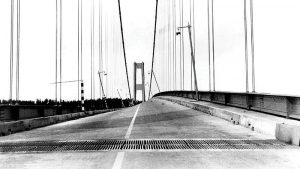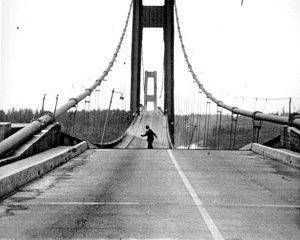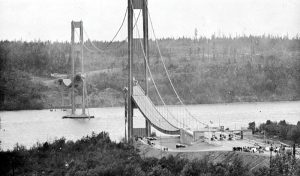Galloping Gertie, Part 2
The design evolution for the Tacoma Narrows Bridge (aka Galloping Gertie) was presented in the February 2022 issue of STRUCTURE. Soon after opening, the Tacoma Narrows Bridge exhibited significant vertical movements under various wind conditions. To address the issue, the owners and designers tried various modifications and were investigating additional steps to control or at least minimize the motions.
Early in the morning on November 7, 1940, sustained winds of 38 miles per hour were recorded, rising to 42 miles per hour by 10:00 AM. Farquharson was at the bridge and noted the deck was raising and falling in sine waves at 38 cycles per minute with a 3-foot double amplitude that was abnormal. He recorded the motion with motion picture and still cameras. Then something happened that had not happened before; the oscillation slowed to 12 cycles per minute and turned from a vertical motion to a two-wave torsional movement. The deck began to twist and roll violently, with the roadway twisting 45 degrees from the horizontal one way, then 45 degrees the other way. He continued filming until the twisting finally collapsed the deck. This film is well known to every civil engineering student.

Kenneth Arkin, the chairman of the Washington State Toll Bridge Authority, arrived at the bridge just before the collapse. After talking to Farquharson, he shut it down shortly after 10:00 AM due to the increased twisting of the deck. The bridge failure ultimately started as the north center stay broke, and the bridge began twisting even more violently in two parts. “Two cars were on the bridge when this wild movement began: one with Leonard Coatsworth, a newspaper reporter, and his cocker spaniel and the other with Arthur Hagen and Judy Jacox. All three people crawled to safety.” Shortly after 11:00 AM, the other stay broke, and the stiffening girders buckled in the middle, followed by the breaking of several suspenders. Most of the main span then dropped into Puget Sound. With a large portion of the center span deck gone, the towers tilted 12 feet towards the anchorages causing significant deflections in the side spans. The failure was complete.
The State of Washington and the United States government both appointed boards of experts to investigate the bridge’s collapse. The insurance companies also established a Narrows Bridge Loss Committee. The Federal Works Administration (FWA) appointed a 3-member panel of top-ranking engineers: Othmar H. Amman, Dr. Theodore Von Karmen, and Glen B. Woodruff. Their report to the Administrator of the FWA, John Carmody, became known as the Carmody Board report. On March 28, 1941, the panel announced its findings; 139 pages plus 8 appendices accessible online through Hathi Trust. They wrote,

“As a result of the investigations which are described in detail in this report, we have reached the following conclusions:
- The Tacoma Narrows Bridge was well designed and built to resist safely all static forces, including wind, usually considered in the design of similar structures. Its failure resulted from excessive oscillations caused by wind action.
- The excessive vertical and torsional oscillations were made possible by the extraordinary degree of flexibility of the structure and of its relatively small capacity to absorb dynamic forces. (emphasis added) It was not realized that the aerodynamic forces, which had proven disastrous in the past to much lighter and shorter flexible suspension bridges, would affect a structure of such magnitude as the Tacoma Narrows Bridge, although its flexibility was greatly in excess of that of any other long-span suspension bridge. (emphasis added)
- The vertical oscillations of the Tacoma Narrows Bridge were probably induced by the turbulent character of wind action. Their amplitudes may have been influenced by the aerodynamic characteristics of the suspended structure. There is, however, no convincing evidence that the vertical oscillations were caused by so-called aerodynamic instability. At the higher wind velocities, torsional oscillations, when once induced, have the tendency to increase their amplitudes. (emphasis added)
- Vertical oscillations of considerable amplitudes were first observed during the erection of the suspended floor and continued, at intervals, until the day of failure. While, at times, the resulting stresses in the stiffening girders were high, there is no evidence that any structural damage resulted. Under certain observed conditions, very high stresses were caused in the ties which connected the suspended floor structure to the cables at mid-span.
- It appears reasonably certain that the first failure was the slipping of the cable band on the north side of the bridge to which the center ties were connected. This slipping probably initiated the torsional oscillations. (emphasis added) These torsional movements caused breaking stresses at various points of the suspended structure, and further structural damage followed almost immediately. The dropping of the greater part of the suspended structure of the center span was made possible by the failure of the suspenders. This was followed by the sudden sagging of the side spans with resulting bending and overstressing of the towers and of the side spans.
- The suspension type is the most suitable and the most economical that could have been selected for the Tacoma Narrows Bridge. No more satisfactory bridge type could have been chosen.
- Both the Public Works Administration and the Reconstruction Finance Corporation were entirely justified in assuming that, because of the experience and reputation of the consultants employed by the Washington Toll Bridge Authority, there could be no possible question as to the adequacy of the design. Both agencies exercised thorough and competent supervision during the construction of the bridge.
- There can be no question that the quality of the materials in the structure, and the workmanship, were of a high order.
- Certain parts of the towers were severely overstressed and permanently deformed during the failure. While there is no visual evidence of damage to the cables, except at the center of the north cable, it is probable that they were overstressed during the torsional oscillations and as a result of the sagging of the side spans. The main piers were not damaged, except locally, during the failure and could possibly withstand considerably heavier tower reactions than they received from the bridge as it existed. The anchorages were not damaged and could safely resist forces greater than those imposed by the original construction.
- The criteria usually considered for rigidity against static forces do not necessarily apply to dynamic forces. (emphasis added)
- The remedial installations in the bridge represented a rational effort to control the amplitudes of the oscillations. Further installations, including diagonal stay ropes from the top of the towers to the floor, were being investigated when the failure occurred, and these would have increased the rigidity. It is doubtful that any measures of this nature would have been sufficient to compensate for the extreme flexibility of the structure. (emphasis added)
- The evidence as to whether the vertical oscillations of the bridge would have been affected by fairing (stream-lining) is inconclusive. There is certain evidence that fairing would have had an unfavorable influence on the torsional stability.
- Further experiments and analytical studies are desirable to investigate the action of aerodynamic forces on suspension bridges.
- Pending the results of further investigations, there is no doubt that sufficient knowledge and experience exist to permit the safe design of a suspension bridge of any practicable span. The results of further research should furnish knowledge that will permit more economical design.
- This report has been restricted to the Tacoma Narrows Bridge, except that available information from other bridges has been considered.”
The report that followed these conclusions was lengthy and comprehensive. It is suggested that the reader looks at the entire Carmody report to learn the state-of-the-art in suspension bridges just prior to WWII and what happens when lessons from the past are either ignored or forgotten.
Clark Eldridge was very vocal about the design stating at different times,
“We were assured that the solid girders would be practical for the Narrows Bridge and besides would be cheaper than the truss work. With this assurance, we adopted the design. I want it to be clear that the bridge collapse was due solely to design. No blame can be attached to the P. W. A. or R.F. C. The blame belongs on the designers. It is extremely unfortunate that the plans they prepared failed.”
From the resonance theory to Van Karman’s vortex shedding hypothesis and most recently torsional flutter, many theories have been advanced over the years as to the actual cause of the failure. Still, all of them agree on one point – that the long length, shallow depth, narrow width, and light weight of the span were factors in the failure. A discussion of all of these theories is beyond the scope of this article.

A new bridge was built ten years later and opened on October 13, 1950. It still serves today, along with a sister parallel bridge constructed in 2007. They have 33-foot-deep open trusses, a deck width of 46 feet, and two 3-foot sidewalks. On the deck, 19-inch open grates along the outside of the outer lanes and 33-inch-wide grates between each lane were installed to permit passage of the winds. In other words, they, except for the grates, resemble the suspension bridges built before the advent of the deflection theory.
What Moisseiff had done was to extend the deflection theory to an extent far beyond what other engineers, including himself, had done in the past. He accomplished this by building a longer, narrower, lighter, and thinner bridge which brought into play aerodynamic forces that had not been encountered with wider, deeper, and heavier bridges. These unforeseen forces resulted in the failure of the bridge. Moisseiff participated in the investigation, but at one time, he said he was “completely at a loss to explain the collapse.” He died three years later without designing any additional bridges. The reader may recall that Theodore Cooper (STRUCTURE, November 2021) recommended lengthening his Quebec middle span by 200 feet, just as Moisseiff had in the Tacoma Narrows Bridge. Just as the Quebec failure ruined Cooper’s reputation, the Tacoma Narrows Bridge failure ruined Moisseiff’s reputation, even though the Board did not explicitly blame him. Unlike the Quebec Bridge that seemed to be safe almost up to the moment of failure, the Tacoma Narrows Bridge underwent severe “galloping” during and after construction. No one believed, despite the galloping, that it was not safe. The same thing could be said of Moisseiff as it was of Cooper and Szlapka at Quebec, “The failure cannot be attributed directly to any cause other than errors in judgment on the part of both engineers.”
O. H. Amman, who was on the Panel of Engineers and had worked extensively with Moisseiff, wrote, “The Tacoma Narrows bridge failure has given us invaluable information…It has shown [that] every new structure [that] projects into new fields of magnitude involves new problems for the solution of which neither theory nor practical experience furnish an adequate guide. It is then that we must rely largely on judgment and if, as a result, errors or failures occur, we must accept them as a price for human progress.”■
